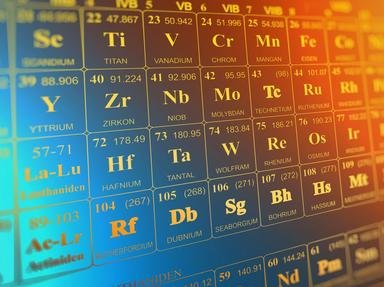Quiz Answer Key and Fun Facts
1. An initial step in the development of the periodic table was the identification of elements. The first scientific discovery of an element was the discovery of phosphorus by an alchemist in 1649. What was the name of this alchemist?
2. The "Law of Triads", proposed by Johann Doebereiner, was an early attempt to classify elements by their relative mass and common properties. Which statement is NOT accurate about Johann Wolfgang Dobereiner.
3. Another attempt to classify and present elements was based on characteristics shown by elements separated by seven steps when elements are listed by relative weights. Because it was similar to musical keys on a piano this classification was called:
4. Dmitry Mendeleev was a teacher of chemistry who began work on the periodic table in the 1860's. What nationality was he?
5. Like Johann Dobereiner, Dmitri Mendeleev did not have outstanding scholastic credentials. Yet he was able to design and develop the original Periodic Table of Elements. Which of the following is true about Mendeleev's academic career?
6. Mendeleev's Periodic Table reflected relationships between elements in triads as well as similarities between elements in vertical and horizontal rows. Which of the following was NOT a result of the Periodic Table of Elements that Mendeleev designed?
7. Lothar Meyer produced a similar periodic table independent of Mendeleev. Why did Meyer not get the credit for the periodic table?
8. Mendeleev was recognized and popular for his work as a scientist and he was a very popular lecturer. Why did he feel it was necessary to resign his position as a professor?
9. In the late 19th century the noble gasses were discovered and another column was added to the periodic table. Who is credited with discovering the Noble gasses and received the 1904 Nobel Prize?
10. In the middle of the 20th century, the work of one man made major changes to the periodic table. He shared the discovery of plutonium and in addition discovered eight other elements. One element #106 is named for him and he shared the Nobel prize for Chemistry in 1951. What was his name?
Source: Author
PALSC
This quiz was reviewed by FunTrivia editor
crisw before going online.
Any errors found in FunTrivia content are routinely corrected through our feedback system.

